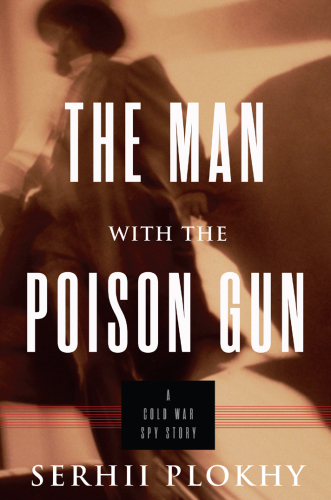
The Man with the Poison Gun
A Cold War Spy Story
کتاب های مرتبط
- اطلاعات
- نقد و بررسی
- دیدگاه کاربران
نقد و بررسی

October 10, 2016
Plokhy (The Gates of Europe), professor of Ukrainian history at Harvard University, details the little-known story of KGB asset Bogdan Stashinsky, who in the late 1950s assassinated two prominent exiled Ukrainian nationalists living in West Germany, using a gun that fired a liquid poison that left no traces. At 19, Stashinsky joined the KGB to escape prosecution for a minor offense and informed on his Ukrainian nationalist family. In 1957, he killed political theorist Lev Rebet, but two years later claimed a more prominent victim: leading Ukrainian nationalist Stepan Bandera. Stashinsky and his East German wife defected to West Germany in 1961, whereupon he was held for interrogation. Plokhy recounts his trial for both murders, which led Soviet leaders to end the policy of assassinating anti-Soviet nationalists, having made martyrs of men like Bandera. Stashinsky received an eight-year sentence, the defense successfully arguing that the real murderers were the Soviet leaders who ordered the killings. After serving six years, he left for South Africa, aiding the country’s government on intelligence that would counter the anti-apartheid movement. Plokhy misses an opportunity to more broadly contextualize the Ukrainian anti-Soviet movement, but his gripping, well-researched account of Stashinsky’s life illuminates a pivotal juncture of the Cold War. Agent: Jill Kneerim, Kneerim & Williams.

October 1, 2016
The story of Ukrainian Bogdan Stashinskys rise from an agricultural student to a KGB assassin who defected to the West in 1961.Stashinskys career as a member of the Soviet secret police did not have an auspicious beginning. As an aspiring university student during the postwar Soviet occupation of Ukraine, he had family ties to the nationalist underground and was sympathetic to anti-Soviet groups. Local Soviet officials knew this well and blackmailed Stashinsky by giving him an ultimatum: betray his loyalties or watch the Soviets persistently harass and potentially assassinate his family members. He chose to collaborate with his occupiers. However, Stashinsky was quickly outed and shunned by his family; with nowhere else to turn, he accepted an offer to join the MGB, a precursor to the KGB. So began his rise as a professional assassin. With gusto and verve, Plokhy (Ukrainian History/Harvard Univ.; The Gates of Europe: A History of Ukraine, 2015, etc.) details Stashinskys intelligence work in East Germany, where he eventually received assignments to assassinate dissident journalist Lev Rebet and Stepan Bandera, leader of the Organization of Ukrainian Nationalists. To complete the deed, he was given a novel device that shot untraceable poison directly into the face of his victims. However, Stashinsky was a reluctant assassin and was eager for reassignment to the West. Upon being recalled to Moscow with his wifeand much KGB meddling with their personal affairshe decided to make a daring escape and defect to West Germany. Ironically, Stashinsky had to prove that he had killed Rebet and Bandera in order to save himself, though that was easier said than done. More than just the story of Stashinskys involvement with the KGB, the book wonderfully details the entire intelligence milieu of postwar Germany, Russia, and much of Eastern Europe, including the paranoid atmosphere created by the legions of secret police that had taken hold throughout the region. A thrilling, well-researched tale of espionage that has all the spycraft hallmarks of a blockbuster movie.
COPYRIGHT(2016) Kirkus Reviews, ALL RIGHTS RESERVED.

November 1, 2016
Plokhy (Mykhailo S. Hrushevs'kyi Professor of Ukrainian History, Harvard Univ.; The Last Empire) recounts the life of Bogdan Stashinsky, a Ukrainian-born KGB-bred assassin. In the late 1950s, Stashinsky murdered two leading Ukrainian nationalists with poison that left no trace, using a weapon that inspired Ian Fleming and countless other authors of spy thrillers. The deaths, although suspicious, were not connected to one another, or to the Soviets. In the years that followed, Stashinsky fell in love, developed a conscience, defected to West Berlin hours before the Berlin Wall was completed, and confessed to the murders. His sensational trial linked the assassinations to the highest levels of the Soviet government. Convicted, Stashinsky was surreptitiously released several years before his sentence came to an end. Using recently opened KGB and CIA files, along with interviews and memoirs of those involved, Plokhy corroborates Stashinsky's tale and makes a fairly convincing case that he fled to South Africa, where he may still be living today, looking over his shoulder for agents intent on retribution. VERDICT Extensively researched and well documented, this fascinating true story will appeal to readers of spy fiction and nonfiction and Eastern European and Cold War history.--Laurie Unger Skinner, Coll. of Lake Cty., Waukegan, IL
Copyright 2016 School Library Journal, LLC Used with permission.

























دیدگاه کاربران